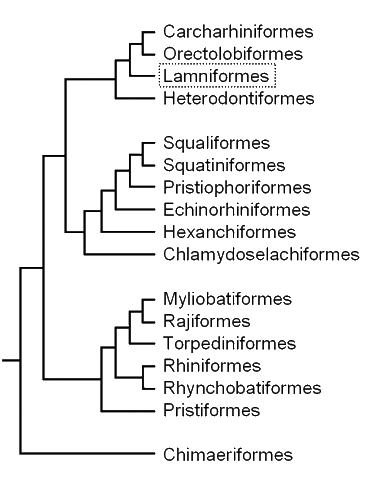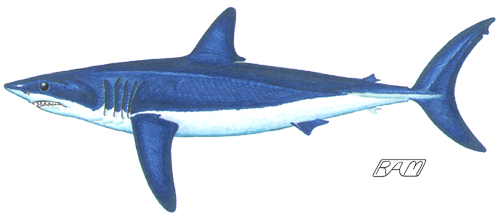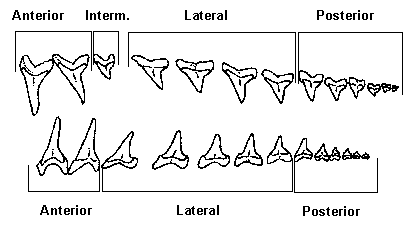Order Lamniformes:
Mackerel Sharks — 15 species

- two dorsal fins, without spines
- anal fin present
- five pairs of gill slits, either entirely in front of the pectoral fin base or with the last two above the pectoral base
- spiracles usually present, small and behind eyes
- eyes without nictitating membrane
- mouth subterminal, jaws extending well behind the eyes
- upper teeth well differentiated along the jaws forming the so-called "lamnoid dental pattern" which features enlarged anterior teeth, slightly to much smaller intermediate teeth, large lateral teeth, followed by much smaller posterior teeth
- intestinal valve of ring type
- ovoviviparous, the fetuses of most forms augmenting their in utero nourishment by feeding on unfertilized eggs (oviphagy or oophagy)
- exclusively marine, in coastal to open-ocean environments; they inhabit cold temperate to tropical zones of the Atlantic, Pacific, and Indian Oceans
- 10 genera in 8 families

|

|

A representative lamnoid, the Shortfin Mako (Isurus oxyrinchus), showing the five pairs of gill slits in front of the pectoral fins, two spineless dorsal fins, and presence of an anal fin, characteristic of the group. In addition, this species exhibits all of the salient characteristics of the Lamnidae — the family that includes the white shark and its closest relatives: conical snout, large dark eyes, crescentic mouth filled with large but relatively few teeth, long gill slits, highly streamlined body, small second dorsal and anal fins, narrow tail stalk with stout lateral keels, and lunate caudal fin. Note also the recurved, smooth-edged teeth that characterize the genus Isurus.
The lamnoids include some of the most spectacular and popular sharks. The Goblin, Sandtiger, Megamouth, threshers, Basking, and the Great White Sharks are all members of this diverse group. In size, the lamnoids range from the little Crocodile Shark (Pseudocarcharias kamoharai) — which grows to 3.6 feet (1.1 metres) long — to the enormous Basking Shark (Cetorhinus maximus) — which grows to a length of at least 32 feet (9.8 metres), and is second only to the orectoloboid Whale Shark (Rhincodon typus) as the largest living fish. Most lamnoids are active, apex predators and some are considered dangerous to humans (the group's scientific name derives from lamia, a horrible, serpent-like monster of Greek mythology with a taste for human flesh). A few lamnoids — namely, the Basking and Megamouth (Megachasma pelagios) sharks — are planktivores, straining tiny animals from the water via bristle- or finger-like gill rakers.
The "Lamnoid Dental Pattern", as displayed by the dentition of the Shortfin Mako (Isurus oxyrinchus), showing enlarged anterior teeth, smaller intermediate(s) (Interm.), large laterals and smaller posteriors. But there are some problems with this apparently neat dental arrangement. In some lamnoids — such as thresher sharks (family Alopiidae) — the 'intermediate' is not significantly reduced and distinction between lateral and posterior teeth can likewise be very difficult. In 1999, paleontologist Mikael Siverson argued that the lamnoid dental pattern — which was originally devised for the Sandtiger Shark (Carcharias taurus) — does not apply to most lamnoids because, in them, the so-called 'intermediate' teeth are not restricted to the intermediate bar (a cartilaginous strut on the inner surface of each of the upper jaw cartilages) but are instead located within the anterior hollow. Thus, Siverson advocates referring to these NON-intermediate teeth as "reduced anteriors". Time will tell whether this dental reclassification will take hold.
Perhaps the most active lamnoids belong to two families: the mackerel sharks (Lamnidae) — which includes two species of mako (genus Isurus) and the Great White (Carcharodon carcharias) — and the thresher sharks (Alopiidae). Lamnids and alopiids have portions of their circulatory system modified in a way which enables them to retain metabolic heat, making them functionally warm-blooded. The Great White is the warmest of all sharks, able to maintain its body as much as 25° Fahrenheit (14° Celsius) above ambient water temperature. Clocked at speeds of at least 35 miles (56 kilometres) per hour, the Shortfin Mako (Isurus oxyrinchus) is probably the fastest sprinter among sharks. Looking like a trimmed-down version of its larger, more infamous cousin — the Great White — the Shortfin Mako is a prodigious leaper, making it much sought-after as a gamefish. The thresher sharks have small teeth but a tremendously hyper-extended upper lobe of the caudal fin, as long as the rest of the fish; although the behavior has not yet been documented, there is strong circumstantial evidence to suggest that threshers use this whip-like tail to stun the schooling fishes and squids on which they feed.
The Goblin Shark (Mitsukurina owstoni) is a bizarre, deep-sea inhabitant. It is strawberry pink in color, with a trowel-shaped head and grows to an impressive length of 11 feet (3.4 metres). With its pointed snout, 'cold' staring eyes, and a mouthful of some of the wickedest-looking teeth in sharkdom, the Sandtiger Shark (Carcharias taurus) looks a lot more dangerous than it actually is, making it a popular exhibit in public aquaria; this species is able to hover, achieving neutral buoyancy by holding air (gulped from the surface) in its stomach. Fetal Sandtigers develop precocious teeth and swimming ability, enabling individual pups to actually feed upon lesser siblings that have the misfortune of sharing their womb (this grisly practice is the only known case of in utero cannibalism in the Animal Kingdom). Ultimately, only two Sandtiger pups are born per litter — one from each uterus.

